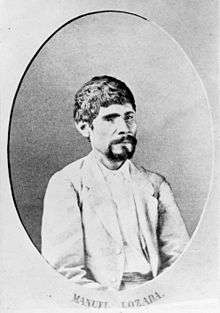Manuel Lozada
| Manuel Lozada | |
|---|---|
 | |
| Nickname(s) | El Tigre de Álica, (The Tiger of Álica) |
| Born |
1828 San Luis, Nayarit |
| Died |
19 July 1873 Loma de los Metales, Nayarit |
| Rank | General |
| Battles/wars | Second French Intervention in Mexico: |
General Manuel Lozada, was the caudillo the region of Tepic, nicknamed The Tigre of Álica. He was (born 1828, Tepic Territory, Mexico - died 19 July 1873 in Loma de los Metates, Nayarit), who was at various points in his life a "bandit, Liberal, Conservative, imperialist, neutral, republican," and is still a controversial figure in Mexican history.[1]
Biography
He was an Indian or mestizo of the Cora tribe, the son of Norberto García and Cecilia González. His father died when he was young and his mother lacked the means to raise him. He was adopted by his uncle José María Lozada, from whom he took his last name. As a boy he helped his uncle to care for the animals on the family farm. When older he attended the parochial school in town. He was unable to complete his elementary-school instruction because he had to contribute to the income of the family—his uncles and aunts, five cousins (three of whom died at a young age of fever).
According to legend he grew up to be a cowboy on the Cerro Blanco hacienda of Pantaleón Gonzálea. He served as a servant to the wife of the farm owner until the latter died. His great love was the daughter of his boss, María Dolores, with whom he eloped. For this he was arrested and sent to the Tepic jail. Once released, he looked for María Dolores and was again taken prisoner. As a result of his mother's pleading he was freed and he again fled in the company of María Dolores to the Sierra de Alica.
When the soldier Simón Mireles was unable to find him, Mireles whipped Lozada publicly in the town square. This incensed Lozada who, in the company of a group of Cora natives with axes to grind with the government, searched for, found, and executed the soldier. The nickname "The Tiger of Alica" was born, and this bandit and sometimes insurgent wreaked havoc for several years in the canton of Tepic.
Another less romantic version says that little is known about his early years. Lozada was a bandit who became prominent during the 1855-56 dispute between two companies in Tepic. Suddenly Lozada ceased to be a bandit when he allied himself with a prominent family of Tepic, the Rivase.
In 1857 he defeated the troops of lieutenant colonel José María Sánchez Román and in 1859 he dispersed the government troops under the command of colonel Valenzuela. On 2 November of the same year he attacked the city of Tepic.
In the 1860s, the followers of Lozada made public the demands of indigenous people for their lands. Since this happened during the French intervention in Mexico, Lozada allied himself with the French. For his services Maximilian I of Mexico repaid him by creating the province of San José de Nayarit, with Tepic as its capital, and by making Lozada a general.
On the 12th of November, 1864, after the French army took possession of Mazatlán, he and his troops entered the city.
Following the execution of Maximilian I of México in 1867, Lozada was shot by his sworn enemy General Ramón Corona in the town of Loma de los Metates. Manuel Lozada is considered the precursor of the agrarian reform movement in Mexico and indirectly of the creation of the state of Nayarit. There are monuments in his honor in the city of Tepic, Nayarit, and the town of his birth, San Luís de Lozada.
References
- ↑ Jean Meyer, "Manuel Lozada" in Encyclopedia of Mexico, Chicago: Fitzroy Dearborn 1997, p. 763.
Further reading
- Aldana Rendón, Mario. Rebelión agraria de Manuel Lozada: 1873. Mexico City: Fondo de Cultura Económica 1983.
- Aldana Rendón, Mario, Pedro Luna, José M. Muriá, and Angélica Peregrina, eds. Manuel Lozada hasta hoy. Zapopan: El Colegio de Jalisco 2007.
- Brittsan, Zachary. Popular Politics and Rebellion in Mexico: Manuel Lozada and La Reforma, 1855-1876. Nashville: Vanderbilt University Press 2015.
- García de Alba, Gabriel Agraz. Quienes resistieron al sanguinario Tigre de Álica en Tequila y lo vencieron en la batalla de La Mojonera. Mexico City: n.p. 1997.
- Meyer, Jean. La tierra de Manuel Lozada. Mexico City:CEMCA 1990.
- Meyer, Jean. "Manuel Lozada" in Encyclopedia of Mexico, Chicago: Fitzroy Dearborn 1997, 763-64.
- Paz, Ireneo. Manuel Lozada: El tigre de Álica. Mexico City: Factoria Ediciones 2000.
- Robinson, Amy. "Manuel Lozada and the Politics of Barbarity." Colorado Review of Hispanic Studies 4 (Fall 2006) 77-94.
- Salinas Solís, Manuel, ed. Manuel Lozada: Luz y Sombra. Mexico City: Comunicación Optima 1999.
Other sources
Entry to Manuel Lozada in the Spanish Wikipedia.